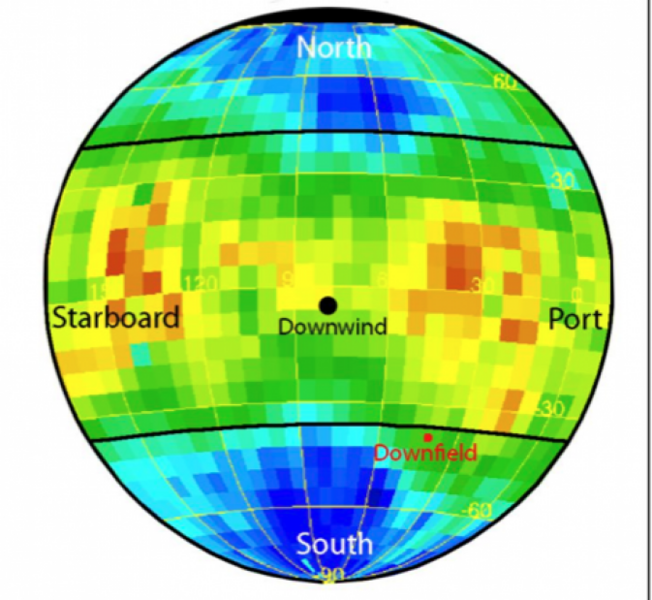NASA's IBEX maps solar system's tail for the first time
Loading...
NASA’s Interstellar Boundary Explorer, or IBEX, has for the first time mapped the tail – or, tails – that stream out behind our solar system as it moves through the galaxy.
Researchers have for years theorized that our solar system should have a tail, just as a comet hurdling through Earth’s atmosphere would have particles streaming out behind it. Telescopes have also spotted tails protruding from other stars, some of them several light-years in length. But this is the first data to confirm the assumption about our own sun, offering a broad portrait of our solar system.
“For the first time ever, humanity has an image of this protective bubble that surrounds the solar system,” said David McComas, lead author on the paper and principal investigator for IBEX at Southwest Research Institute, in a phone interview. “Ibex has allowed us to fill in the hole in that image and measure one of the heliosphere’s biggest features, the heliotail.”
The heliosphere is a magnetic region extending about 8 billion miles from the sun to the heliopause, the outermost boundary of our solar system. It is inflated with what is known as the solar wind: fast and charged particles blowing out at millions of miles per hour from the sun in all directions, carrying with them the sun’s magnetic field. Those particles then collide with neutral atoms entering the solar system from elsewhere in the galaxy and in that collision exchange an electron. That creates a fast neutral atom and a slow-moving particle.
Some of those neutral atoms, released from the sun’s magnetic field, then ricochet back in a straight line toward IBEX, which is in orbit around Earth. Researchers use the received data to put together a picture of the activity at the solar system’s boundary, mapping the charged particles that are still held in the magnetic field and that trail out like a tail behind the solar system. That trail is a result of the relative motion between the heliosphere and the local interstellar medium as they travel through the galaxy.
The mapping technique is known as energetic neutral atom imaging and differs from most space imaging, which usually depends on light.
The first IBEX images, released in 2009, initially pictured a streamer-like band of high energetic neutral atom emissions circling the upwind side of the solar system. But subsequent images revealed much more to the picture, imaging four different lobes all making up the tail. The results are published in The Astrophysical Journal.
“An earlier analysis made the tail looked much smaller. We’ve realized that the original tail was just a fraction of a much larger structure,” said Dr. McComas.
The researchers are using seafaring terms to distinguish the lobes, only two of which are pictured in the visualization. One lobe is called the port and the other the starboard. In that analogy, the heliosphere is referred to as the vessel, ferrying the solar system through the galaxy.
To visualize the tail, picture a globe rendered two dimensionally. The side of the globe we are looking at is the downwind side. The opposite side is the upwind side. It is unknown exactly how much distance is between the two - in other words, how long the tail is.
"The tail's end is somewhat ambiguous," said Eric Christian, IBEX mission scientist at NASA’s Goddard Space Flight Center, noting that is estimated to be about 100 billion miles long.
The port side of our 2-dimensional globe, some 10 billion miles wide, is to the east, and the starboard side is to the west. The low-latitudes of the globe are filled with slow moving particles, and the fast moving particles are at the northern and southern most end of the visualization. That's because fast-moving particles tend to originate from the sun's poles.
The globe, not quite symmetrical, is tilted to put the port side somewhat higher than the starboard side. That comes from the heliosphere’s interaction with the interstellar magnetic fields as it moves – the magnetic field exerts a force on the tail, flattening it and somewhat twisting it.
Dr. Christian told the Monitor that IBEX researchers are next looking to understand how time influences the heliotail, since the sun’s behavior changes in an 11 year cycle. The data received is from the sun during its quiet phase, and the particles blown out during the sun's current active phase will take some 3-5 years to reach IBEX, he said.
Much is unknown about the outer edge of our solar system. Researchers are still waiting for Voyager 1, launched some 35 years ago and now more than 11 billion miles afield from the sun, to leave the heliosphere for interstellar space.
In June, the spacecraft identified a previously unknown space region called the magnetic highway, or the depletion region. Scientists are hoping – but still unsure – that this is the region directly abutting the heliopause and is the final area through which Voyager 1 must pass to exit the solar system.
"We're still understanding our own solar system," said Dr. Christian. "These thing are close, on relative scale, but we don’t know anything about them."






